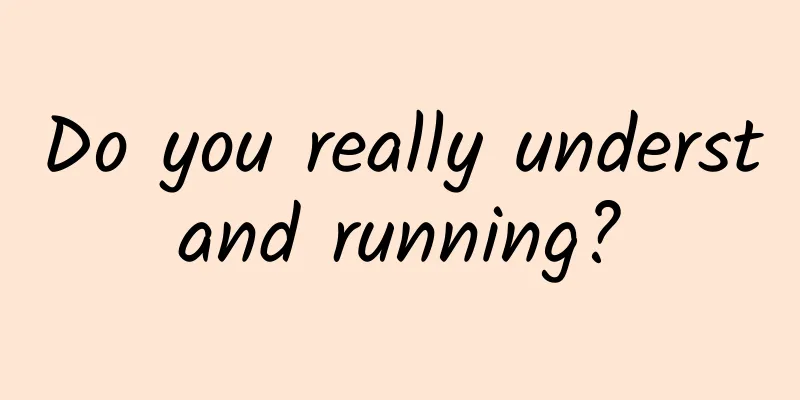Do you really understand running?

|
According to statistics, 30% to 60% of people are injured while running every year, and 30% to 50% of these injuries are related to the knee. Zhang San said: After running, my knees hurt when I go up and down the stairs. Li Si talks: Why does the inner side of the knee hurt after running? Wang Wudao: My knees hurt after running for two weeks, so I don’t run anymore. Zhao Liu said: I want to run, but my knees hurt so I dare not run. Sun Qitan: Why do some people run every day without any knee problems? This may be the confusion encountered by many people. They all know that running is good for the body, but when injuries occur, they don’t know what to do. So they give up on themselves and refuse to exercise from then on, and they are afraid to talk about the word "running". So, why do running knees hurt? We must first understand the anatomical characteristics of the knee joint. The knee joint is the most complex joint in the human body. The tibial and fibular collateral ligaments are attached to the inner and outer sides of the knee joint respectively; there are anterior and posterior cruciate ligaments inside, which have a certain restraining effect on the anterior and posterior movement of the tibia; there are menisci and synovial fluid in the joint cavity. The knee joint is the key link connecting the thigh and calf, and the flexion and extension of the knee joint plays a leading role when people walk and run, especially in the process of running, it plays a role in transmitting and buffering impact force, so it is very easy to get injured during running. However, it is not running that causes knee joint injuries, but the wrong running method. When running, people will mobilize the muscles and joints of the whole body to coordinate movements. Only when all parts of the body are in the best posture, that is, when the movement sequence of each joint is the most reasonable, then when the body bears the impact force, the impact force can be best buffered and transmitted. What should the correct posture be? The "forward leaning posture" invented by Russian kinesiologist Nicholas Romanov is recommended: that is, the upper body is slightly tilted forward, the head is located directly above the torso, and the forward leaning range should be natural and comfortable. If you lean forward too much, it will increase the burden on the back muscles; if you lean back, it will cause excessive tension in the chest and abdominal muscles. When running, lift your shoulders slightly, bend your elbows to 90 degrees, half-clench your hands, relax your arms and swing them back and forth naturally, slightly inward when swinging forward, and slightly outward when swinging backward. The swing range should not be too large, and the force should not be too strong. During running, the thighs are actively lifted forward, the calves are naturally relaxed, and the hips are driven forward and upward by the forward swinging movement of the thighs. Joggers should land on their heels first and then quickly transition to landing on the entire sole of the foot, so that the back push is fully powerful and the stride is large and elastic. If the running action is wrong, such as the order of foot landing is incorrect, the ground force during the landing and pushing off the ground cannot be transmitted well, and a huge force is generated on the knee joint or other parts, causing sports injuries. The reasons for the wrong action pattern include: insufficient muscle strength in the core area, buttocks and medial thigh, poor pelvic-hip joint coordination, insufficient ankle dorsiflexion range of motion, poor core stability, etc. These factors often lead to imbalance and disorder in the power chain arrangement of the lower limbs, causing compensatory knee inward buckling, compressing the arch of the foot, and bearing greater impact force on the knee joint. Scientific running also requires strengthening muscle training, especially training of the hip muscles. Because when the supporting foot lands, in order to buffer the reaction force, the joints of the leg will be prepared to absorb this force. If the hip muscles are insufficient, the hip joint will become excessively displaced, leaving the reaction force that should have been transmitted to the knee. Over time, the knee will be injured. If you just run blindly and ignore strength training, resulting in insufficient muscle strength, then too much training load will be transferred to the joints and their soft tissues, and sports injuries will occur in the knee area over time. So, don't just run! Wrong way to run 1. Landing on the whole sole of the foot Many people are used to landing on the whole sole of the foot when running. In fact, this landing method is not correct. Because there is no cushioning and transition when landing, it is easy to "squat" and it is easy to hurt the cervical spine. This is especially true when running on hard ground such as cement and stone. In the long run, it is easy to cause tibial periostitis. 2. When running with your toes touching the ground, the toes will strongly stimulate the calf muscles, which will make the calves thicker over time and form "carrot legs". 3. Too long stride When starting to run and exercise, some people like to increase their stride to improve the exercise effect. In fact, increasing the stride will inevitably cause a longer air time, greater fluctuations in the center of gravity, and heavy landing force, which will increase the vibration of the human body. When exercising on a treadmill, you should choose the appropriate speed according to your own ability. Strides and stride frequencies that exceed your own ability may increase the risk of exercise. 4. Inward and outward feet. Some people have "inward and outward feet" when walking. If they still have "inward and outward feet" when running, the knees and toes cannot be kept in the same direction, which will increase the burden on the knee joints and easily cause damage to the knee joints and other parts in the long run. 5. Leaning forward or backward too much Running forward will cause tension in the back, while running backward will cause excessive tension in the chest and abdominal muscles, which will cause abnormalities in the shoulders, neck and back over time. 6. Swaying left and right Some enthusiasts, especially teenagers, like to sway their bodies left and right while running, thinking that this makes running more exciting, just like the "shaking" action when riding a bicycle. In fact, this will not only increase unnecessary physical energy consumption, but also destroy the linearity of running, affecting the speed and effect. |
>>: Ladies who are on the road to losing weight, how are you?
Recommend
Tangerine peel, tangerine peel, and green peel can all regulate qi and resolve phlegm. Do you know the difference between them?
Tangerine peel, tangerine peel, and green tangeri...
Is something growing on the cervix usually cervical cancer?
Many women are worried about developing cervical ...
Yellow vaginal discharge and yellow urine
To a certain extent, women's leucorrhea can n...
What is the uterine curettage procedure like?
We all know that abortion surgery is extremely ha...
What to do if you don't have your period after curing your uterus
Curettage surgery is mainly used in situations wh...
What to do if a pregnant woman is infected with a virus
In the season when influenza is prone to occur, e...
Can pregnant women eat seed watermelon?
The pregnant woman was originally a first-class p...
How to use cleaning solution to clean the vulva?
As we all know, the structure of the female repro...
How are hawthorn strips made? Nutritional content of hawthorn strips
In supermarkets, we often see a variety of hawtho...
How to regulate your body if you want a boy
Physical and mental health is the only wealth of ...
What are the benefits of eating pumpkin seeds for women
Pumpkin seeds are a common snack. Pumpkin seeds l...
Girl's underwear mucus during menstrual period
Many girls do not pay too much attention to some ...
I'm under a lot of pressure! Should I see a psychologist?
Insomnia, anxiety, irritability... The fast-paced...
32 weeks fetus real picture
At 32 weeks of pregnancy, the weight of the fetus...
Is it true that getting angry can damage your liver?
People often say that bad emotions hurt the liver...









